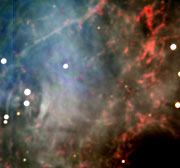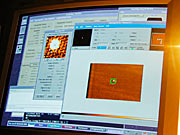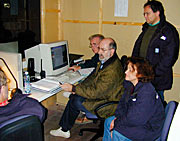Comunicato Stampa
And Then There Were Three...!
VLT MELIPAL Achieves Successful "First Light" in Record Time
28 Gennaio 2000
This was a night to remember at the ESO Paranal Observatory! For the first time, three 8.2-metre Very Large Telescopes (VLTs) were observing in parallel, with a combined mirror surface of nearly 160 metres squared. In the evening of January 26, the third 8.2-metre Unit Telescope, MELIPAL ("The Southern Cross" in the Mapuche language), was pointed to the sky for the first time and successfully achieved "First Light". During this night, a number of astronomical exposures were made that served to evaluate provisionally the performance of the new telescope. The ESO staff expressed great satisfaction with MELIPAL and there were broad smiles all over the mountain.
The first images
Following two days of preliminary adjustments after the installation of the secondary mirror, cf. ESO Press Photos eso0003, MELIPAL was pointed to the sky above Paranal for the first time, soon after sunset in the evening of January 26. The light of a bright star was directed towards the Guide Probe camera, and the VLT Commissioning Team, headed by Dr. Jason Spyromilio, initiated the active optics procedure. This adjusts the 150 computer-controlled supports under the main 8.2-metre Zerodur mirror as well as the position of the secondary 1.1-metre Beryllium mirror. After just a few iterations, the optical quality of the recorded stellar image was measured as 0.46 arcsec (ESO Press Photo eso0004), a truly excellent value, especially at this stage!
Immediately thereafter, at 22:16 hrs local time (i.e., at 01:16 hrs UT on January 27), the shutter of the VLT Test Camera at the Cassegrain focus was opened. A 1-min exposure was made through a R(ed) optical filter of a distant star cluster in the constellation Eridanus (the River). The light from its faint stars was recorded by the CCD at the focal plane and the resulting frame was read into the computer.
Despite the comparatively short exposure time, myriads of stars were seen when this "first frame" was displayed on the computer screen. Moreover, the sizes of these images were found to be virtually identical to the 0.6 arcsec seeing measured simultaneously with a monitor telescope, outside the telescope enclosure. This confirmed that MELIPAL was in very good shape. Nevertheless, these very first images were still slightly elongated and further optical adjustments and tests were therefore made to eliminate this unwanted effect. It is a tribute to the extensive experience and fine skills of the ESO staff that within only 1 hour, a 30 sec exposure of the central region of the Crab Nebula in Taurus with round images was obtained, cf. ESO Press Photo eso0004.
The ESO Director General, Dr. Catherine Cesarsky, who assumed her function in September 1999, was present in the Control Room during these operations. She expressed great satisfaction with the excellent result and warmly congratulated the ESO staff to this achievement.
She was particularly impressed with the apparent ease with which a completely new telescope of this size could be adjusted in such a short time. A part of her statement on this occasion was recorded on ESO Press Video eso0002 that accompanies this Press Release.
Three telescopes now in operation at Paranal
At 02:30 UT on January 27, 2000, three VLT Unit Telescopes were observing in parallel, with measured seeing values of 0.6 arcsec (ANTU - "The Sun"), 0.7 arcsec (KUEYEN -"The Moon") and 0.7 arcsec (MELIPAL).
MELIPAL has now joined ANTU and KUEYEN that had "First Light" in May 1998 and March 1999, respectively. The fourth VLT Unit Telescope, YEPUN ("Sirius") will become operational later this year.
While normal scientific observations continue with ANTU, the UVES and FORS2 astronomical instruments are now being commissioned at KUEYEN, before this telescope will be handed over to the astronomers on April 1, 2000.
The telescope commissioning period will now start for MELIPAL, after which its first instrument, VIMOS will be installed later this year.
Sul Comunicato Stampa
| Comunicato Stampa N": | eso0004 |
| Legacy ID: | PR 01/00 |
| Nome: | Crab Nebula, Eridanus Constellation, First Light, M 1, Messier 1, NGC 1952, Taurus A |
| Tipo: | Milky Way : Star Milky Way : Star : Evolutionary Stage : Neutron Star Milky Way : Nebula : Type : Supernova Remnant Milky Way : Sky Phenomenon : Night Sky : Constellation |
| Facility: | Very Large Telescope |
Our use of Cookies
We use cookies that are essential for accessing our websites and using our services. We also use cookies to analyse, measure and improve our websites’ performance, to enable content sharing via social media and to display media content hosted on third-party platforms.
ESO Cookies Policy
The European Organisation for Astronomical Research in the Southern Hemisphere (ESO) is the pre-eminent intergovernmental science and technology organisation in astronomy. It carries out an ambitious programme focused on the design, construction and operation of powerful ground-based observing facilities for astronomy.
This Cookies Policy is intended to provide clarity by outlining the cookies used on the ESO public websites, their functions, the options you have for controlling them, and the ways you can contact us for additional details.
What are cookies?
Cookies are small pieces of data stored on your device by websites you visit. They serve various purposes, such as remembering login credentials and preferences and enhance your browsing experience.
Categories of cookies we use
Essential cookies (always active): These cookies are strictly necessary for the proper functioning of our website. Without these cookies, the website cannot operate correctly, and certain services, such as logging in or accessing secure areas, may not be available; because they are essential for the website’s operation, they cannot be disabled.
Functional Cookies: These cookies enhance your browsing experience by enabling additional features and personalization, such as remembering your preferences and settings. While not strictly necessary for the website to function, they improve usability and convenience; these cookies are only placed if you provide your consent.
Analytics cookies: These cookies collect information about how visitors interact with our website, such as which pages are visited most often and how users navigate the site. This data helps us improve website performance, optimize content, and enhance the user experience; these cookies are only placed if you provide your consent. We use the following analytics cookies.
Matomo Cookies:
This website uses Matomo (formerly Piwik), an open source software which enables the statistical analysis of website visits. Matomo uses cookies (text files) which are saved on your computer and which allow us to analyze how you use our website. The website user information generated by the cookies will only be saved on the servers of our IT Department. We use this information to analyze www.eso.org visits and to prepare reports on website activities. These data will not be disclosed to third parties.
On behalf of ESO, Matomo will use this information for the purpose of evaluating your use of the website, compiling reports on website activity and providing other services relating to website activity and internet usage.
Matomo cookies settings:
Additional Third-party cookies on ESO websites: some of our pages display content from external providers, e.g. YouTube.
Such third-party services are outside of ESO control and may, at any time, change their terms of service, use of cookies, etc.
YouTube: Some videos on the ESO website are embedded from ESO’s official YouTube channel. We have enabled YouTube’s privacy-enhanced mode, meaning that no cookies are set unless the user actively clicks on the video to play it. Additionally, in this mode, YouTube does not store any personally identifiable cookie data for embedded video playbacks. For more details, please refer to YouTube’s embedding videos information page.
Cookies can also be classified based on the following elements.
Regarding the domain, there are:
- First-party cookies, set by the website you are currently visiting. They are stored by the same domain that you are browsing and are used to enhance your experience on that site;
- Third-party cookies, set by a domain other than the one you are currently visiting.
As for their duration, cookies can be:
- Browser-session cookies, which are deleted when the user closes the browser;
- Stored cookies, which stay on the user's device for a predetermined period of time.
How to manage cookies
Cookie settings: You can modify your cookie choices for the ESO webpages at any time by clicking on the link Cookie settings at the bottom of any page.
In your browser: If you wish to delete cookies or instruct your browser to delete or block cookies by default, please visit the help pages of your browser:
Please be aware that if you delete or decline cookies, certain functionalities of our website may be not be available and your browsing experience may be affected.
You can set most browsers to prevent any cookies being placed on your device, but you may then have to manually adjust some preferences every time you visit a site/page. And some services and functionalities may not work properly at all (e.g. profile logging-in, shop check out).
Updates to the ESO Cookies Policy
The ESO Cookies Policy may be subject to future updates, which will be made available on this page.
Additional information
For any queries related to cookies, please contact: pdprATesoDOTorg.
As ESO public webpages are managed by our Department of Communication, your questions will be dealt with the support of the said Department.





